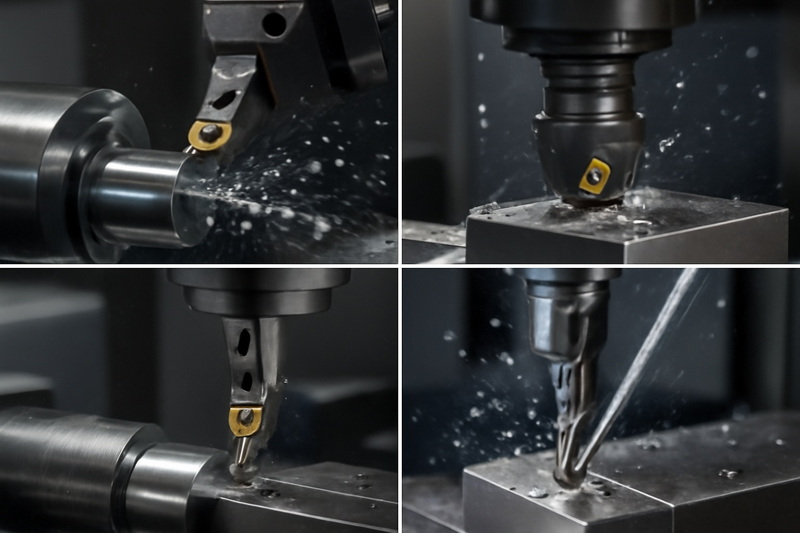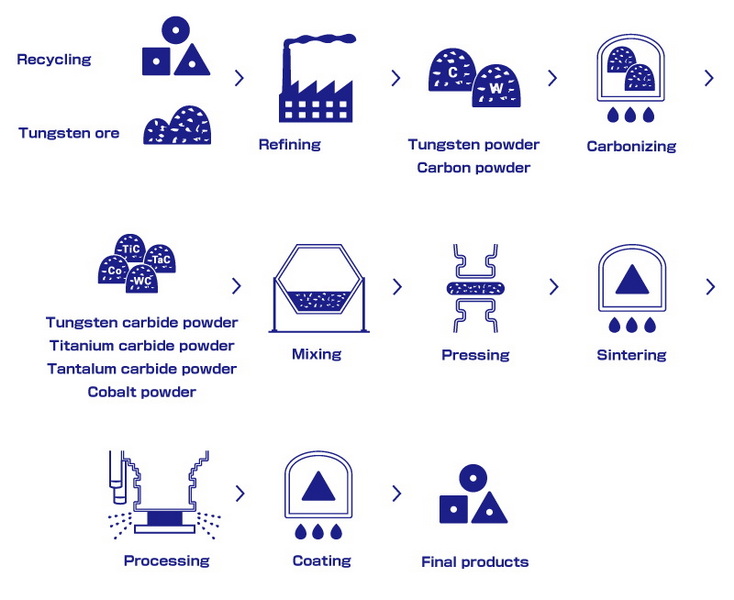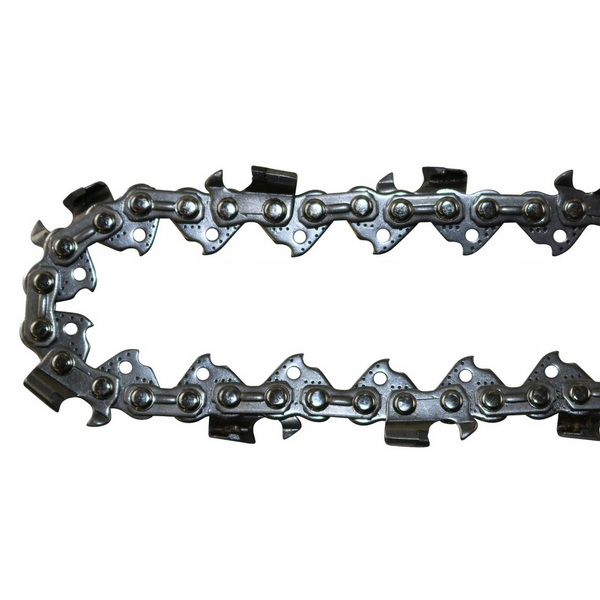Content Menu
● What Are Tungsten Carbide Inserts?
● The Composition and Properties of Tungsten Carbide
● How Tungsten Carbide Inserts Are Made
>> 1. Powder Preparation
>> 2. Mixing and Milling
>> 3. Pressing
>> 4. Sintering
>> 5. Coating (Optional)
>> 6. Quality Control and Finishing
● Types and Shapes of Tungsten Carbide Inserts
● Key Applications Across Industries
>> 1. Metalworking and Machining
>> 2. Woodworking
>> 3. Automotive and Aerospace
>> 4. Oil & Gas
>> 5. Medical and Electronics
● Advantages of Using Tungsten Carbide Inserts
● How to Choose the Right Tungsten Carbide Insert
● Care, Maintenance, and Recycling
● History and Evolution of Tungsten Carbide Inserts
● Innovations in Manufacturing Techniques
● Future Trends and Developments
● Conclusion
● FAQ: Frequently Asked Questions
>> 1. What makes tungsten carbide inserts superior to traditional steel tools?
>> 2. Can tungsten carbide inserts be used for both metal and wood cutting?
>> 3. How do I know when to replace a tungsten carbide insert?
>> 4. Are tungsten carbide inserts recyclable?
>> 5. What are the most common shapes of tungsten carbide inserts and their uses?
Tungsten carbide inserts are at the heart of modern machining, manufacturing, and woodworking. These remarkable cutting tools have revolutionized the way industries shape, cut, and finish materials. In this comprehensive guide, we'll explore what tungsten carbide inserts are, how they're made, their types, applications, advantages, and how to choose the right insert for your needs. Along the way, you'll find visual explanations to make complex concepts clear and accessible.

What Are Tungsten Carbide Inserts?
Tungsten carbide inserts are small, replaceable cutting tools made from a composite material of tungsten carbide and a metal binder, typically cobalt. These inserts are designed to be attached to tool holders in lathes, milling machines, drills, and other machinery. Their primary function is to cut, shape, and finish metals, wood, plastics, and other materials with high precision and durability.
The Composition and Properties of Tungsten Carbide
Tungsten carbide is a chemical compound consisting of equal parts tungsten and carbon atoms. This combination results in a material that is exceptionally hard, dense, and wear-resistant. The addition of a binder metal, usually cobalt, gives the insert toughness and the ability to withstand the intense forces of cutting and machining.
Key Properties:
- Hardness: Tungsten carbide is one of the hardest materials used in industry, second only to diamond.
- Wear Resistance: It resists abrasion and maintains a sharp edge far longer than traditional tool steels.
- Heat Resistance: It retains its hardness even at high temperatures, making it ideal for high-speed machining.
- Toughness: The binder metal provides enough toughness to resist chipping and breaking under heavy loads.
How Tungsten Carbide Inserts Are Made
The manufacturing of tungsten carbide inserts is a precise, multi-step process that ensures each insert meets strict performance standards.
1. Powder Preparation
High-purity tungsten carbide and cobalt powders are carefully measured and mixed. Sometimes, additives like titanium carbide or tantalum carbide are included to enhance specific properties.
2. Mixing and Milling
The powders are thoroughly blended in mixers and then ground in ball mills to achieve a uniform, fine particle size. A liquid medium, such as alcohol, is used to prevent oxidation during milling.
3. Pressing
The mixed powder is pressed into the desired insert shape using high-pressure molds. This creates a “green compact” that is still fragile.
4. Sintering
The green compacts are heated in a furnace at temperatures around 1400°C. The cobalt melts and binds the tungsten carbide particles together, forming a dense, hard insert.
5. Coating (Optional)
Many inserts receive a hard coating, such as titanium nitride or aluminum oxide, to further improve wear resistance and performance.
6. Quality Control and Finishing
Each insert is inspected for dimensional accuracy, hardness, and surface quality before packaging.

Types and Shapes of Tungsten Carbide Inserts
Tungsten carbide inserts come in a wide variety of shapes, sizes, and geometries, each tailored for specific cutting operations.
| Insert Type | Common Shapes | Typical Applications |
| Turning Inserts | Triangular, Diamond | General turning, profiling |
| Milling Inserts | Square, Round | Face milling, shoulder milling |
| Drilling Inserts | Round | Drilling, boring |
| Grooving Inserts | Special | Grooving, parting |
| Threading Inserts | V-shaped | Internal and external threading |
| Special Purpose | Custom | Tailored for unique requirements |
Popular Shapes:
- Round: Best for finishing and curved surfaces.
- Diamond: Ideal for profiling and fine detail work.
- Triangle: Common in turning and facing operations.
- Square: Used in milling for strong cutting edges.
- Rectangle and Parallelogram: For specialized cuts and stability.
Key Applications Across Industries
Tungsten carbide inserts are indispensable in numerous industries due to their versatility and performance.
1. Metalworking and Machining
- Turning, Milling, Drilling, Boring: Used in CNC machines and lathes for shaping metals like steel, aluminum, and cast iron.
- Grooving and Threading: Creating precise grooves and threads in workpieces.
2. Woodworking
- Planer and Woodturning Tools: Inserts provide smooth finishes and extended tool life, even in high-speed operations.
3. Automotive and Aerospace
- Engine Components: Machining engine blocks, transmission parts, and turbine blades.
- High-Precision Parts: Used for critical applications requiring tight tolerances and durability.
4. Oil & Gas
- Drilling Equipment: Inserts withstand the extreme conditions of drilling and exploration.
5. Medical and Electronics
- Surgical Instruments: Precision machining of medical-grade metals.
- Electronic Components: Used in the fabrication of intricate parts.
Advantages of Using Tungsten Carbide Inserts
1. Extended Tool Life
Tungsten carbide inserts last much longer than high-speed steel tools, reducing downtime and tool replacement costs.
2. Superior Cutting Performance
They maintain a sharp edge even under high-speed, high-temperature conditions, resulting in cleaner cuts and better surface finishes.
3. Versatility
With a wide range of shapes and sizes, inserts can be tailored for nearly any material or machining operation.
4. Cost-Effective
Although the initial cost is higher, their longevity and replaceability make them economical in the long run.
5. Easy Replacement
Indexable inserts can be quickly swapped out without removing the entire tool holder, minimizing machine downtime.
How to Choose the Right Tungsten Carbide Insert
Selecting the right insert depends on several factors:
- Material to Be Cut: Different grades and coatings are optimized for steel, cast iron, aluminum, or non-ferrous materials.
- Type of Operation: Turning, milling, drilling, or threading each requires specific insert geometries.
- Machine Capability: Consider the speed, feed rate, and rigidity of your machine.
- Desired Surface Finish: Finer inserts produce smoother finishes, while tougher inserts handle roughing operations.
Tip: Consult with your tooling supplier or refer to manufacturer catalogs for recommended insert grades and geometries for your specific application.
Care, Maintenance, and Recycling
- Proper Storage: Store inserts in dry, organized containers to prevent chipping and corrosion.
- Regular Inspection: Check for wear, chipping, or dullness and replace inserts as needed.
- Recycling: Used tungsten carbide inserts are valuable and can be recycled to recover tungsten and cobalt for new inserts.
History and Evolution of Tungsten Carbide Inserts
The development of tungsten carbide inserts dates back to the early 20th century when industries sought harder and more durable materials for cutting tools. Initially, high-speed steel was the standard, but it lacked the wear resistance needed for high-speed machining. The invention of tungsten carbide composites revolutionized the tooling industry by providing a material that could withstand higher temperatures and maintain sharpness longer.
Over the decades, advancements in powder metallurgy and coating technologies have significantly improved the performance and lifespan of tungsten carbide inserts. Today, these inserts are engineered with precision to meet the demands of modern manufacturing processes.
Innovations in Manufacturing Techniques
Recent innovations in manufacturing techniques have enhanced the quality and capabilities of tungsten carbide inserts. Techniques such as nano-grain technology allow for finer microstructures, resulting in improved toughness and wear resistance. Additionally, advanced coating methods like chemical vapor deposition (CVD) and physical vapor deposition (PVD) provide superior surface hardness and reduce friction during cutting.
Automation and computer-controlled sintering processes ensure consistent quality and dimensional accuracy, enabling manufacturers to produce inserts tailored for specific applications with minimal variability.
Future Trends and Developments
The future of tungsten carbide inserts is promising, with ongoing research focused on developing even harder and more wear-resistant materials. Hybrid composites combining tungsten carbide with ceramics or other advanced materials are being explored to push the limits of cutting tool performance.
Sustainability is also a growing focus, with efforts to improve recycling processes and reduce the environmental impact of manufacturing. Smart inserts equipped with sensors to monitor wear and performance in real-time are emerging, offering predictive maintenance capabilities and further optimizing machining operations.
Conclusion
Tungsten carbide inserts are a cornerstone of modern manufacturing, offering unmatched hardness, wear resistance, and versatility. Whether you're machining metal, wood, or composites, these inserts deliver performance and reliability that traditional tools simply can't match. By understanding their properties, types, and applications, you can select the right insert to maximize productivity and achieve superior results in your projects.

FAQ: Frequently Asked Questions
1. What makes tungsten carbide inserts superior to traditional steel tools?
Tungsten carbide inserts are much harder and more wear-resistant than traditional steel tools. They maintain their cutting edge longer, especially at high speeds and temperatures, resulting in improved efficiency and surface finish.
2. Can tungsten carbide inserts be used for both metal and wood cutting?
Yes, tungsten carbide inserts are highly versatile and can be used for cutting metals, wood, plastics, and composites. Specialized shapes and grades are available for each application to ensure optimal performance.
3. How do I know when to replace a tungsten carbide insert?
Replace an insert when you notice diminished cutting performance, poor surface finish, increased cutting forces, or visible wear such as chipping or dullness. Regular inspection helps prevent tool failure and ensures consistent results.
4. Are tungsten carbide inserts recyclable?
Absolutely. Used inserts contain valuable tungsten and cobalt, which can be recovered and reused in new inserts. Many suppliers offer recycling programs for spent inserts.
5. What are the most common shapes of tungsten carbide inserts and their uses?
- Round: Best for finishing and curved surfaces.
- Diamond: Used for profiling and detail work.
- Triangle: Common in general turning.
- Square: Preferred for milling and strong cutting edges.
Each shape is designed for specific operations, so choose according to your machining requirements.
















